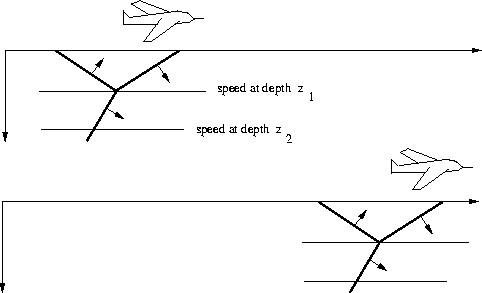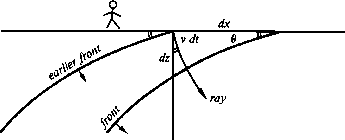 |
Figure 8 Fast airplane radiating a sound wave into the earth. From the figure you can deduce that the horizontal speed of the wavefront is the same at depth z1 as it is at depth z2. This leads (in isotropic media) to Snell's law.
In reflection seismic surveys the velocity contrast between shallowest and deepest reflectors ordinarily exceeds a factor of two. Thus depth variation of velocity is almost always included in the analysis of field data. Seismological theory needs to consider waves that are just like plane waves except that they bend to accommodate the velocity stratification v(z). Figure 8 shows this in an idealized geometry: waves radiated from the horizontal flight of a supersonic airplane.
 |
The airplane passes location x at time t0(x)
flying horizontally at a constant speed.
Imagine an earth of horizontal plane layers.
In this model there is nothing to distinguish any point
on the x-axis from any other point on the x-axis.
But the seismic velocity varies from layer to layer.
There may be reflections, head waves, shear waves, converted waves,
anisotropy, and multiple reflections.
Whatever the picture is, it moves along with the airplane.
A picture of the wavefronts near the airplane moves along with the airplane.
The top of the picture and the bottom of the picture both move laterally at
the same speed even if the earth velocity increases with depth.
If the top and bottom didn't go at the same speed,
the picture would become distorted,
contradicting the presumed symmetry of translation.
This horizontal speed, or rather its inverse ![]() ,has several names.
In practical work it is called the
stepout.
In theoretical work it is called the
ray parameter.
It is very important to note that
,has several names.
In practical work it is called the
stepout.
In theoretical work it is called the
ray parameter.
It is very important to note that ![]() does not change with depth,
even though the seismic velocity does change with depth.
In a constant-velocity medium, the angle of a wave
does not change with depth.
In a stratified medium,
does not change with depth,
even though the seismic velocity does change with depth.
In a constant-velocity medium, the angle of a wave
does not change with depth.
In a stratified medium,
![]() does not change with depth.
does not change with depth.
Figure 9 illustrates the differential geometry of the wave.
Notice that triangles have their
hypotenuse on the x-axis and the z-axis
but not along the ray.
That's because this figure refers to wave fronts.
(If you were thinking the hypotenuse would measure ![]() ,it could be you were thinking of the tip of a ray
and its projection onto the x and z axes.)
,it could be you were thinking of the tip of a ray
and its projection onto the x and z axes.)
 |
The diagram shows that
 |
(8) | |
| (9) |
Snell's law relates the angle of a wave
in one layer with the angle in another.
The constancy of equation (8) in depth is really just
the statement of Snell's law.
Indeed, we have just derived Snell's law.
All waves in seismology propagate in a
velocity-stratified medium. So they cannot be called
plane waves. But we need a name for waves that are
near to plane waves. A Snell wave will be defined to be the generalization of a plane wave
to a stratified medium v(z).
A plane wave that happens to enter a medium
of depth-variable velocity v(z) gets changed into a Snell wave.
While a plane wave has an angle of propagation, a
Snell wave has instead a Snell parameter ![]() .
.
It is noteworthy that
Snell's parameter ![]() is directly
observable at the surface,
whereas neither v nor
is directly
observable at the surface,
whereas neither v nor ![]() is directly observable.
Since
is directly observable.
Since ![]() is not only observable,
but constant in depth, it is customary to use it
to eliminate
is not only observable,
but constant in depth, it is customary to use it
to eliminate ![]() from equations (8) and (9):
from equations (8) and (9):
 |
(10) | |
| (11) |